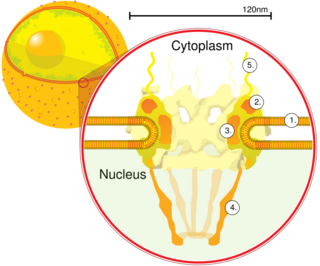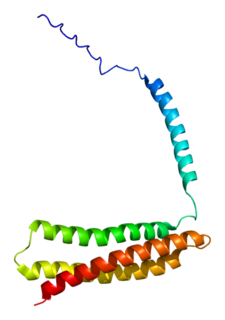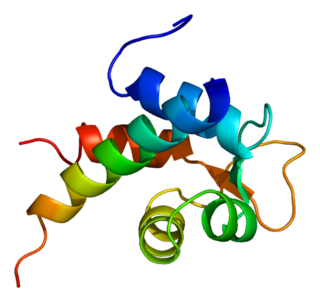
Desmoplakin is a protein in humans that is encoded by the DSP gene. Desmoplakin is a critical component of desmosome structures in cardiac muscle and epidermal cells, which function to maintain the structural integrity at adjacent cell contacts. In cardiac muscle, desmoplakin is localized to intercalated discs which mechanically couple cardiac cells to function in a coordinated syncytial structure. Mutations in desmoplakin have been shown to play a role in dilated cardiomyopathy, arrhythmogenic right ventricular cardiomyopathy, striate palmoplantar keratoderma, Carvajal syndrome and paraneoplastic pemphigus.

Nucleoporin p62 (p62) is a protein complex associated with the nuclear envelope. The p62 protein remains associated with the nuclear pore complex-lamina fraction. p62 is synthesized as a soluble cytoplasmic precursor of 61 kDa followed by modification that involve addition of N-acetylglucosamine residues, followed by association with other complex proteins.

AP-2 complex subunit alpha-1 is a protein that in humans is encoded by the AP2A1 gene.

Spectrin alpha chain, erythrocyte is a protein that in humans is encoded by the SPTA1 gene.

Alpha II-spectrin, also known as Spectrin alpha chain, brain is a protein that in humans is encoded by the SPTAN1 gene. Alpha II-spectrin is expressed in a variety of tissues, and is highly expressed in cardiac muscle at Z-disc structures, costameres and at the sarcolemma membrane. Mutations in alpha II-spectrin have been associated with early infantile epileptic encephalopathy-5, and alpha II-spectrin may be a valuable biomarker for Guillain–Barré syndrome and infantile congenital heart disease.

Alpha-adducin is a protein that in humans is encoded by the ADD1 gene.

Alpha-actinin-2 is a protein which in humans is encoded by the ACTN2 gene. This gene encodes an alpha-actinin isoform that is expressed in both skeletal and cardiac muscles and functions to anchor myofibrillar actin thin filaments and titin to Z-discs.

Spectrin beta chain, brain 1 is a protein that in humans is encoded by the SPTBN1 gene.

Ran-binding protein 9 is a protein that in humans is encoded by the RANBP9 gene.

Beta-adducin is a protein that in humans is encoded by the ADD2 gene.

Alpha-centractin (yeast) or ARP1 is a protein that in humans is encoded by the ACTR1A gene.

Nuclear distribution protein nudE-like 1 is a protein that in humans is encoded by the NDEL1 gene.

Receptor-type tyrosine-protein phosphatase-like N, also called "IA-2", is an enzyme that in humans is encoded by the PTPRN gene.

Protein unc-13 homolog B is a protein that in humans is encoded by the UNC13B gene.

Fasciculation and elongation protein zeta-1 is a protein that in humans is encoded by the FEZ1 gene.

Receptor-type tyrosine-protein phosphatase N2 (R-PTP-N2) also known as islet cell autoantigen-related protein (ICAAR) and phogrin is an enzyme that in humans is encoded by the PTPRN2 gene. PTPRN and PTPRN2 are both found to be major autoantigens associated with insulin-dependent diabetes mellitus.

Spectrin beta chain, brain 2 is a protein that in humans is encoded by the SPTBN2 gene.

Ankyrin 1, also known as ANK-1, and erythrocyte ankyrin, is a protein that in humans is encoded by the ANK1 gene.

Ankyrin-3 (ANK-3), also known as ankyrin-G, is a protein from ankyrin family that in humans is encoded by the ANK3 gene.

Spectrin, beta, non-erythrocytic 5 also known as SPTBN5 is a protein that in humans is encoded by the SPTBN5 gene. SPTBN5 belongs to the spectrin family of cytoskeletal proteins.























